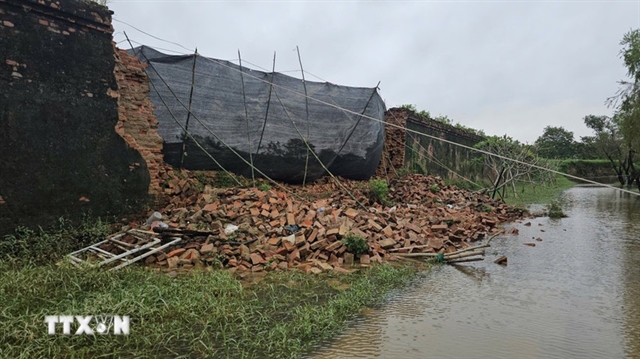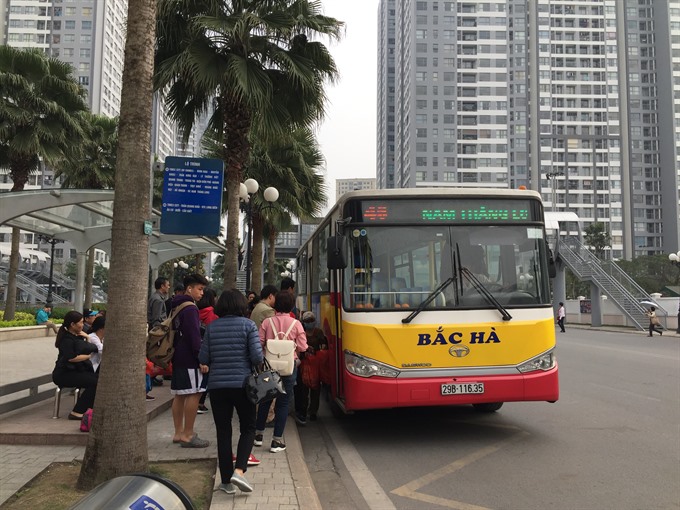 Society
Society

After a long decline, in 2017, for the first time the number of bus riders in Hà Nội has witnessed the increase of more than three per cent. According to experts, the improvement of bus stops and shelters can enhance the public transport’s attraction to passengers.
 |
| Modern bus shelters help enhance passengers’ bus-riding experiences. — VNA/VNS Photo Khoa Thư |
HÀ NỘI – After years of decline, in 2017 the number of bus riders in Hà Nội increased by more than three per cent, however experts say improved bus stops and shelters will make public transport even more attractive.
From January this year, Lê Xuân Tùng, a fourth-year student of Foreign Trade University decided to give up on his scooter to ride buses instead. He described the city’s bus system as convenient and cheap. With more than 100 routes and nearly 3,000 stops, Tùng can travel across the city with a student one-month pass of VNĐ100,000 (US$4.4). However, in reality it’s not all sunshine and rainbows.
“Bus shelters? They are terrible. Bad design along with chaotic traffic turns my waiting time into a mental and physical torture,” he said.
Nguyễn Ngọc Anh in Hai Bà Trưng District would simply like proper shelters.
“First-time riders can never tell where the bus stop on Tam Trinh Street is as the route board is hung up high. There is no pavement and behind it is a construction site so we have to stand on the street waiting for buses,” she told Việt Nam News.
According to Hà Nội Urban Transport Management and Operation Centre, there are only 370 shelters at more than 2,900 bus stops, meaning nearly 88 per cent of stops are not sheltered.
Đỗ Mạnh Hùng in Long Biên District told Kinh tế Đô thị (Economy and the City) newspaper that he preferred taxies on days with bad weather.
“I am a frequent bus rider. However, on rainy, freezing or hot summer days, standing waiting for buses at unsheltered stops makes me feel vulnerable,” he said.
Some bus shelters have also become gathering spaces for vendors and xe ôm (motor taxi) drivers or even garbage dumps.
The bus stop in front of Alley No.2 on Thái Hà Street, for example, is surrounded by a dozen trash bins, while the bus stop opposite Medicine University Hospital on Phạm Ngọc Thạch Street turns into a grilled pork stall every afternoon. The situation is worse at the bus stop in front of Nước Ngầm bus station.
“Not only are we verbally harassed by taxi and xe ôm drivers, we have to chase buses as they can’t stop. The place that should be the bus stop has long been a parking lot,” Nguyễn Thanh Huyền in Hoàng Mai District said.
Worsen in the suburban
In outlying areas, bus stops and shelters are put too near main roads, posing threats of traffic accidents for both bus riders and drivers.
On the old National Highway No.1 across Thanh Trì, Thường Tín and Phú Xuyên districts, the railway runs parallel to the road and bus stop signs are on the other side of the railway fence. Without a pavement, bus riders have to stand on the road, facing trucks, cars and motorbikes driving at high speeds.
The situation is similar on national highways 21B, 21A and 32.
PhạmVăn Nam in Thanh Oai District worries that he’ll be hit when getting off the bus as National Highway No. 21B is narrow and busy.
Ba Vì and Sơn Tây districts, on other hand, have bus stops in secluded areas which make people feel unsafe when waiting for buses.
According to Hà Nội Transport Corporation (Transerco), most bus routes to the outskirts have no bus shelter. Moreover, some departure and arrival points are still temporary and lack ticket offices or waiting rooms.
Systematic solutions in need
Nguyễn Công Nhật, deputy director of Transerco, stressed the significance of considering bus stops and shelters in urban public transportation design, saying the bus stop system needs to be planned before new routes are put into operation.
Added services such as parking lots or ticket offices have to be planned beforehand to improve passengers’ experiences, he said.
“The modern shelters can attract advertisements, helping to re-invest and improve buses,” said Nhật.
Bus stops and shelters also connect bus routes and other means of public transportation such as bus rapid transit (BRT) or metro.
Administrative intervention is needed to address these drawbacks.
Ngô Mạnh Tuấn, deputy director of Hà Nội Department of Transport, said the department was trying to persuade railway agencies and district authorities to set up safe bus stops.
“However, as the issue involves several stakeholders, we are waiting for their full participation to handle it,” he said.
Hà Nội authorities need to take stronger action to protect and improve bus stops and shelters, Thạch Minh Quân, a lecture from University of Transport, said.
“The management of public transport infrastructure should be tightened through educating and strictly handling people who damage or destroy bus stops and shelters,” Quân said.
With air pollution in Hà Nội at alarming levels, it’s urgent to encourage more people to use public transportation instead of private vehicles. Punctuality, modern buses and better bus stops and shelters will help achieve this. Therefore, it is urgent to upgrade infrastructure to help tackle pollution. – VNS




